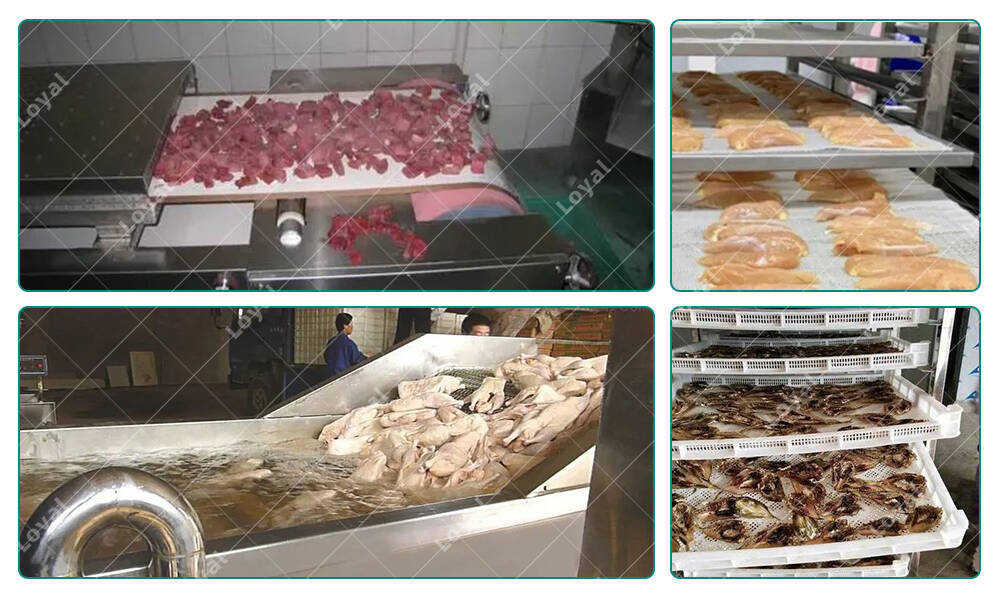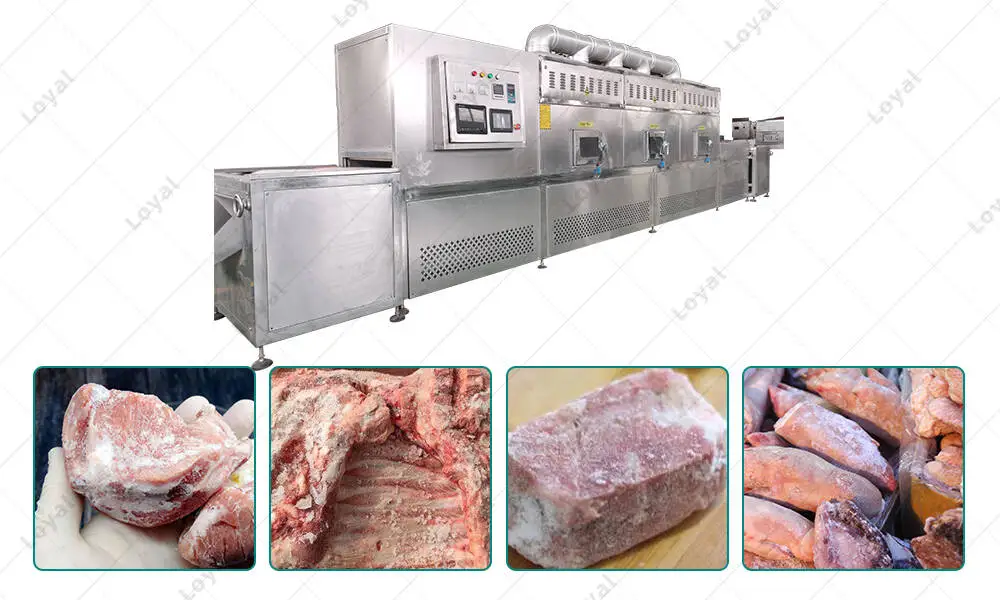What Is an Acceptable Method for Thawing Food? Your Guide to Safe Defrosting Practices
The process of thawing food, a seemingly simple step in food preparation, holds a complexity that cannot be overlooked. Safe thawing practices are paramount to maintaining the integrity, quality, and safety of food, making it a subject of utmost importance for both home cooks and professionals in the food industry. The risks associated with improper thawing methods—such as the growth of harmful bacteria—are a significant concern. These risks can lead to foodborne illnesses, which underscore the necessity of adhering to safe defrosting practices.
When food is not thawed correctly, it becomes a breeding ground for bacteria such as Salmonella, E. coli, and Listeria. These pathogens thrive in the "danger zone," temperatures between 40°F and 140°F (4°C and 60°C), where food can quickly become unsafe to consume. As Dr. James Marsden, a renowned food safety expert, cautions, "The thawing process must be managed carefully to ensure food safety. Improper thawing can negate all other efforts to produce safe and high-quality food." This statement highlights the critical nature of selecting appropriate thawing methods to prevent foodborne illnesses.
The introduction of Industrial Defrosting Equipment has revolutionized safe thawing practices, offering efficient and controlled methods that minimize the risks associated with traditional thawing techniques. This guide aims to explore the significance of proper thawing, the role of Industrial Defrosting Equipment, and the best practices for safely bringing food from frozen to ready-to-cook states. Understanding these elements is crucial for anyone involved in food preparation, ensuring that the food served is not only delicious but also safe to eat.
Understanding Thawing Food
Thawing, in the context of food preparation, is the process of bringing frozen food to a temperature at which it can be safely cooked or consumed. This step is not merely about convenience; it's a critical phase that directly impacts food quality, safety, and overall culinary outcomes. The science behind safe thawing practices illuminates the importance of this process, highlighting why it is crucial for maintaining food quality and ensuring consumer safety.
At the heart of safe thawing is the principle of temperature control. Food must be kept out of the "danger zone," a temperature range between 40°F and 140°F (4°C and 60°C), to prevent the rapid multiplication of bacteria that can cause foodborne illnesses. Thawing methods that maintain temperature control are essential for food safety. As food safety authority Dr. Elizabeth Andress notes, "The key to safe thawing is minimizing the time food spends in the danger zone. Effective thawing methods are designed to ensure that foods do not become unsafe before they are cooked."
The science of thawing extends beyond mere temperature management; it also involves understanding the physical changes that occur in food as it transitions from frozen to thawed. Water molecules within the food expand when frozen, and as they thaw, they return to their original state. This process, if not managed correctly, can lead to texture degradation, nutrient loss, and increased susceptibility to bacterial growth. Therefore, selecting a thawing method that minimizes these adverse effects is vital for maintaining the nutritional value and sensory qualities of food.
In summary, thawing is a complex process influenced by several factors, including the type of food, its size, and the intended use after thawing. The ultimate goal of safe thawing is to ensure that food retains its quality and is free from pathogens that could pose health risks. This understanding forms the foundation for exploring the role of Industrial Defrosting Equipment in achieving these objectives, offering a glimpse into the advancements that have been made in food safety and preparation technology.

The Role of Industrial Defrosting Equipment
The introduction of Industrial Defrosting Equipment represents a significant advancement in the realm of food safety and efficiency. This equipment, designed with the precise needs of the food industry in mind, provides a controlled environment for thawing, ensuring that food is brought to safe temperatures without compromising its quality. Understanding the role, types, and advantages of this equipment is essential for those in the food service and production sectors.
Introduction to Industrial Defrosting Equipment
Industrial Defrosting Equipment is engineered to address the challenges associated with traditional thawing methods. By employing technologies that evenly distribute temperature and reduce thawing time, this equipment minimizes the risk of bacterial growth and ensures that food remains in optimal condition for further processing or cooking. The significance of these technologies cannot be understated, as they directly contribute to the safety and efficiency of food preparation processes.
Types of Industrial Defrosting Equipment
There are several types of Industrial Defrosting Equipment, each designed to meet specific needs within the food industry:
- Air-Based Systems: Utilize controlled air flow and temperature to thaw food evenly. These systems are ideal for a wide range of products, offering versatility and efficiency.
- Water-Based Systems: Employ water at controlled temperatures to thaw food rapidly. These systems are particularly effective for dense products that require quick thawing times.
- Microwave and Radio Frequency Systems: Use electromagnetic waves to generate heat within the food, speeding up the thawing process. These systems are suited for high-throughput environments where time is of the essence.
Advantages of Using Industrial Defrosting Equipment
The advantages of using Industrial Defrosting Equipment over traditional methods are manifold:
- Consistency and Uniformity: Provides even thawing across all parts of the food, eliminating cold spots where bacteria can thrive.
- Speed: Significantly reduces thawing time, increasing operational efficiency and productivity.
- Quality Preservation: Maintains the texture, flavor, and nutritional value of food by minimizing cell damage during thawing.
- Safety: By keeping food out of the danger zone, these systems reduce the risk of foodborne illnesses, ensuring that food is safe to consume.
The adoption of Industrial Defrosting Equipment in food processing and preparation underscores a commitment to food safety and quality. As Dr. Rebecca Robertson, a food technology expert, asserts, "The use of advanced thawing technologies is a game-changer in the food industry. It not only enhances food safety but also contributes to better quality and reduced waste." This equipment has become indispensable for businesses aiming to meet the high standards of today's food industry, marking a significant step forward in the pursuit of excellence in food safety and preparation.
Acceptable Methods for Thawing Food
Understanding and implementing acceptable methods for thawing food are crucial steps in ensuring food safety and quality. While traditional methods have their place, the advent of Industrial Defrosting Equipment has revolutionized these processes, offering more controlled and efficient options. This section delves into the conventional methods for thawing food and explores how industrial equipment can enhance these practices for commercial use.
Conventional Thawing Methods
Three primary methods are widely recognized as safe for thawing food:
- Refrigeration Thawing: Thawing food slowly in the refrigerator is the safest method, as it keeps food out of the danger zone throughout the thawing process. However, this method requires foresight and significant time, often up to 24 hours or more, depending on the size of the item.
- Cold Water Thawing: This method involves submerging food in cold water, changing the water every 30 minutes to ensure it remains cold. It's faster than refrigeration thawing but requires more attention to maintain safe temperatures.
- Microwave Thawing: The quickest method, microwave thawing is best used when the food will be cooked immediately after thawing. It can cause uneven thawing and may partially cook some sections of the food, making it less ideal for large or dense items.
Enhancement Through Industrial Defrosting Equipment
Industrial Defrosting Equipment takes these basic principles and applies technological advancements to improve efficiency, safety, and food quality:
- Enhanced Refrigeration Thawing: Industrial systems can closely control air temperature and circulation, speeding up the refrigeration thawing process while maintaining uniform conditions that prevent bacterial growth.
- Optimized Cold Water Thawing: By precisely controlling water temperature and flow, industrial thawing equipment can thaw food more quickly and uniformly than manual cold water thawing, reducing labor and improving safety.
- Advanced Microwave and RF Thawing: Commercial-grade microwave and radio frequency (RF) thawing systems offer rapid, even thawing with minimal quality degradation. These systems are designed to overcome the limitations of household microwaves by evenly distributing energy and reducing hot spots.
Industrial Defrosting Equipment not only accelerates the thawing process but also enhances the quality and safety of the food. These systems provide a controlled environment that mitigates the risks associated with traditional thawing methods, making them an invaluable asset in commercial food preparation and processing settings.
In conclusion, while traditional thawing methods remain viable options for safe food preparation, the integration of Industrial Defrosting Equipment into these processes represents a significant advancement in food safety and quality. By adopting these technologies, food service providers can ensure that they are offering the highest standard of food safety to their customers, aligning with industry best practices and regulatory guidelines.

Guidelines for Safe Thawing Practices
Ensuring food safety extends into every aspect of handling and preparation, with thawing being a critical step that requires careful attention. The use of Industrial Defrosting Equipment has provided a more consistent, efficient, and safer way to thaw food. However, to maximize the benefits of this technology, it's essential to follow specific guidelines that ensure food safety and quality are maintained throughout the thawing process.
Step-by-Step Guide Using Industrial Defrosting Equipment
Selection of the Appropriate Equipment: Choose the right Industrial Defrosting Equipment based on the type of food and the quantity being thawed. Different foods may require specific thawing methods to preserve quality and safety.
Preparation: Ensure that the food is properly packaged or contained to prevent cross-contamination and to preserve food quality during the thawing process.
Setting Parameters: Configure the equipment to the correct settings for the specific food item. This includes temperature, thawing time, and any specific requirements that the manufacturer recommends.
Monitoring: Continuously monitor the thawing process to ensure the equipment is functioning correctly and that the food is thawing evenly. Adjustments should be made as necessary to avoid any areas remaining frozen or becoming too warm.
Final Inspection: Once the thawing process is complete, inspect the food to ensure it has thawed thoroughly and evenly. Foods that have not been evenly thawed should not be processed further until the thawing is complete.
Immediate Processing or Refrigeration: After thawing, food should be cooked immediately or moved to refrigeration if it will not be used right away. This minimizes the risk of bacterial growth.
Tips for Ensuring Food Safety and Quality
- Avoid Thawing at Room Temperature: Never thaw food on the countertop or at room temperature, as this can place food in the danger zone for bacterial growth.
- Use Protective Gear: When handling food and operating Industrial Defrosting Equipment, always use appropriate protective gear to maintain hygiene and prevent contamination.
- Regular Maintenance: Keep Industrial Defrosting Equipment in optimal condition through regular maintenance and cleaning, following the manufacturer's guidelines to prevent malfunction and contamination.
By adhering to these guidelines, those in the food service and processing industries can leverage Industrial Defrosting Equipment to its full potential, ensuring food safety and quality are upheld. The implementation of these practices underscores a commitment to food safety standards, reflecting an understanding of the critical role that proper thawing plays in the overall food preparation process.
Conclusion
The journey through understanding and implementing safe thawing practices underscores the pivotal role that thawing plays in the broader context of food safety and quality. From exploring the basics of thawing food to delving into the advanced capabilities of Industrial Defrosting Equipment, it's clear that the methods and technologies we employ can significantly impact the safety, quality, and efficiency of food preparation processes.
Industrial Defrosting Equipment has emerged as a cornerstone in the evolution of thawing practices, offering solutions that mitigate the risks associated with traditional methods. By harnessing these technologies, the food industry can achieve a balance between operational efficiency and stringent safety standards, ensuring that the food served to consumers is not only delicious but, more importantly, safe.
In conclusion, the acceptance and implementation of proper thawing methods, particularly through the use of Industrial Defrosting Equipment, are integral to advancing food safety practices. As we continue to navigate the complexities of food preparation, the emphasis on safe, efficient, and quality-focused thawing methods will undoubtedly play a crucial role in shaping the future of the food industry. Let this guide serve as a reminder of the importance of selecting an acceptable method for thawing food, encouraging ongoing education and adherence to best practices in support of culinary excellence and public health.












